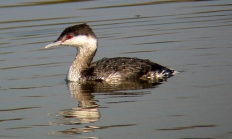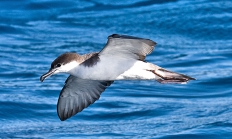Search myodfw.com
This large loon breeds in the Arctic tundra from Northwestern Russia across Siberia and Alaska through Canada to Hudson Bay. It winters in North America along the coast of South Alaska and British Columbia, and regularly in small numbers south to Baja, California. The majority of Oregon records are of transient birds found between early November and early June. Hear the call of the yellow-billed loon Photo by Mark Peck, Flickr

The pied-billed grebe is an aquatic species that breeds at the edge of open water in freshwater lakes, ponds, sluggish rivers, and marshes. When disturbed, it sinks like a submarine, rather than diving, and re-emerges with only its head above water. This is a brownish grebe with a black vertical bar in the middle of the rather stubby, whitish bill, and jet-black throat patch on both sexes in alternate plumage. It has a surprisingly loud "yelping" call within a marsh. Young have striking stripes on the head. This bird is widespread and common in Oregon. It winters locally in open

In alternate plumage this striking bird's lower neck, chest, and sides are bright chestnut. Three groups of yellow plumes adorn the sides of the head. Its head and throat are black. This grebe favors areas with much open water surrounded with emergent vegetation. The horned grebe is a rare breeder east of the Cascades. Malheur National Wildlife Reserve averages four to five pairs per summer. It is also rare along the coast in summer and is an uncommon spring and fall transient on lakes, reservoirs, and large rivers west of the Cascades and uncommon to common east of the Cascades

This medium-sized, shy grebe has bright white cheeks that contrast sharply against a dark crown and rust red neck during the breeding season. An aquatic bird, it breeds in lakes and ponds, usually in forested areas. In Oregon, it is found in waters with hardstem bulrush intermixed with open water over five feet deep. Five to 20 birds at Rocky Point in the Upper Klamath Lake National Wildlife Reserve form the only consistent breeding population in Oregon. The red-necked grebe reaches its greatest numbers during winter along the coast. The red-necked grebe is an Oregon Conservation Strategy Species in the

This salt-loving bird is possibly the most abundant grebe in the world. These grebes nest in the large, tule-fringed marshes of southeastern Oregon. They also use almost any open water for feeding after the breeding season. The eared grebe has been reported breeding in nearly every eastern Oregon county, but principal breeding areas are in Klamath, Lake, and Harney counties. It is local elsewhere east of the Cascades. Hear the call of the eared grebe Photo by Dave Budeau, ODFW

The largest of Oregon's grebes, these have a long white neck, black cap, bright red iris, long strait bill, dark back, bright white breast, and they appear tailless. While excellent divers, they are unable to walk on land because their body weight is forward of their legs. Differences in appearance between western and Clark's grebes are subtle. In the western grebe, the black cap typically extends down to the eye whereas white facial plumage extends slightly above the eye on the Clark's grebe, but this is not always diagnostic in winter. The western grebe is a common breeder in eastern

Clark's grebe is very similar in plumage, habitat, and behavior to the western grebe. It breeds in inland lakes with emergent vegetation such as cattails and tules. It requires open water for foraging on the surface or diving below in pursuit of fish. It winters both along the seacoast and on major rivers. Like the western grebe, Clark's grebe is a specialist in fish, which make up over 80 percent of its diet. It will also eat other aquatic organisms like crayfish, amphibians, and aquatic insects. Its breeding range in Oregon overlaps that of western grebe, but Clark's is not

Popularly called "Gooneybird" for its elaborate mating antics and clumsy takeoffs and landings and breeding islands, this is a large, spectacular seabird. Though small for an albatross, it glides on wind currents just above the ocean waves on long narrow wings which span approximately six-and-a-half feet. The dark gray wings, back and tail contrast with a white body and upper tail coverts. Singles or small groups are reported occasionally on offshore Oregon birding trips, primarily in winter. Hear the call of the Laysan albatross Photo by ©Greg Gilson

A big, well-mannered bird of friendly, even playful disposition, with an abundant curiosity as to human presence and activities within the realm of open ocean over which he presides. Long-winged, to seven feet, and dark sooty-brown; adults have a white rump and feathering, which juveniles lack, around the base of a large bill. Every sighting of these gentle giants gliding up to the boat evokes delight. The black-footed albatross is a regular visitant spring through fall offshore, but is irregular in winter. They glean squid, fish and fish eggs from the ocean surface and also eat galley scraps. Hear the

One of Oregon's characteristic offshore seabirds, these stocky gull-like birds with steep foreheads come in a broad range of color morphs from white to slate gray, with buffy, bluish-gray, mottled and brown intermediates. The round head and pecking motion of birds feeding on the water is reminiscent of the shape and behavior of pigeons. The heavy hooked bills are divided into colorful plates of green, yellow, and orange, with large tubed nostrils atop. They are irregularly common to abundant in Oregon in winter, especially beyond five miles from shore. Hear the call of the Northern fulmar Photo by Martyne Reesman

The mottled petrel breeds in New Zealand and nearby islands, and ranges throughout much of the Pacific Ocean, mostly far from land. It is a common May to October visitant in the northern and eastern North Pacific, with non-breeding birds occurring during the winter months. Photo by Dominique, Flickr

The world population of this species, which probably does not exceed 25,000 pairs, is quite low for a seabird. Nevertheless, these are the common light-bellied shearwaters off Oregon in summer. They are larger, bulkier, and fly more deliberately than the usually much more abundant sooty shearwaters with which they associate. They are uniform gray-brown above; the underparts are white; the vent and underwings variably smudged with dusky. The pinkish bill is dark-tipped and the feet are pink. It is a common summer visitor and very common fall transient offshore on shallow shelf waters. It is usually seen seaward, approximately five

Flesh-footed shearwaters are always exciting birds to find, as they are one of the rarest of the seabirds to occur annually in Oregon. Single birds are sometimes found in flocks of other shearwaters. They are very similar to sooty shearwaters but they are larger with pink or pale whitish feet and dark-tipped pale bills. In addition, their plumage is a deep chocolate-brown, lacking the grayness of the upperpart coloration of sooty shearwaters; and the underwing does not show the sooty's white coverts. It is a rare late fall transient offshore at the western edge and slopes of the continental shelf

Few seabirds have been labeled "stunning;" but with their graceful flight, boldly patterned upperparts, and brilliant white underparts, these birds truly are one of the most beautiful in Oregon waters. They have a black cap, wings angled forward, long body and tail, and a unique dark 'M' pattern against light gray back and wings. Often seen in small groups mixed among other more abundant shearwaters, they sometimes form pure flocks all flying in gracefully synchronized flight. While regular in Oregon in late fall, they are still uncommon enough to excite observers when encountered at sea. Photo by Tony Morris, Flickr

This seabird, the most abundant in Oregon, has recently suffered severe declines or significant population shift in the eastern North Pacific. Similar in shape to thin, long-winged gulls, sooty shearwaters are dark sooty gray with limited amounts of white on the underwing coverts. They glide on wind currents along wave troughs on stiff wings. Gregarious, they form huge loose flocks in migration, often passing for hours within site of land-based observers. In Oregon, it is an abundant summer visitor and transient offshore on the inner shelf and is most numerous three to six miles offshore. Hear the call of the

These very abundant seabirds are uncommon off Oregon in winter. Their arrival coincides with some of the Pacific Northwest's stormiest weather. Complicating detection difficulties is their identification; they look very much like the abundant sooty shearwaters - all dark, but slightly smaller with shorter bills and tails. Studied on their Tasmanian breeding grounds continuously for over 45 years, once they leave for the open ocean little is known about them. Popularly know as "muttonbirds," they have been harvested as food for centuries on their southern seas breeding islands. Even today, up to 300,000 chicks are harvested in Tasmania each year

In Oregon, fork-tailed storm-petrels breed in numbers that are only a tiny fraction of those of Leach's storm petrels. This is the larger of the two storm-petrels breeding in Oregon and is gray in color. These birds leave and return to breeding colonies only at night, when they are best detected by their distinct raspy call. At sea, they are distinguished by quick, buoyant flight with short glides interspersed with wing fluttering to maintain their position at a food source. Fewer than 20 nests have been found in Oregon, all located in the same habitat as colonies of Leach's storm

Of Oregon's breeding seabirds, Leach's storm-petrel is the smallest, most pelagic, and flies the farthest offshore of any of Oregon's breeding seabirds to feed. It spends the non-breeding season in the subtropical and equatorial Pacific. It is the second most abundant breeding seabird in Oregon, and is rarely seen from land or close to shore. It comes to its breeding islands, where it nests in burrows, only under the cover of darkness. Its plumage is black and Oregon populations have a distinct white rump. Leach's storm-petrels are long lived birds characterized by long-term pair bonds and may breed yearly for

Oregon has two species of pelicans, American white and the Brown pelican, and three species of cormorants. All are fish-eating water birds with four toes joined by webbing. Depending on the species, pelicans and cormorants inhabit the Oregon coast, rivers or interior waterbodies.

Large and primarily white, the American white pelican has the longest wingspan of any bird in Oregon. It also has an enormous orange bill, and flies with neck withdrawn. During the breeding season the top of the bird's head becomes dusted with black and a horn grows on the upper mandible; this projection serves as a target for aggressive encounters to avoid injury to the essential bill pouch, but is shed after the eggs are laid. This pelican makes unusually long flights for feeding and migration, and at great distances, soaring flocks have been reported as UFOs. In Oregon, it

